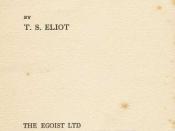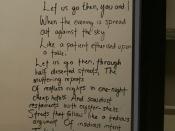Though the title of Eliot's poem, "The Love Song of J. Alfred Prufrock" leads the reader to believe it will be a sweet poem, the juxtaposition of the epigraph right after the title deeply contrasts the initial thought. It is from Dante's Inferno and explores the suffering and uncertainty in Prufrock. Translated, the epigraph is Guido de Montefeltro confessing his sins to Dante assuming that he, like all others, will not be able to escape the depth, the depth being Hell, and therefore not be able to tell others of his sins. Prufrock, much like Guido, tells his story, his self-doubt and insecurities to the reader because he believes the reader will not speak of it to anyone else. Also, the prologue paints the image of Prufrock isolated in a personal hell not unlike a person stuck in the fiery depths of hell.
Eliot uses different techniques to display Prufrock's true character and thoughts.
The repetition of questions displays Prufrock's insecurities, uncertainties, and indecisiveness. He repeats "Do I dare?" several times and says, "Do I dare/ Disturb the universe?" Not only does his repetition of "Do I dare?" show his insecurities but he questions his every day actions and existence. He asks approximately thirteen questions throughout the poem. He even asks himself "Do I dare to eat a peach?" He constantly wonders what others will think of him and his actions or thoughts. He doubts that people will understand him and that is shown with his echoing of the phrase "That is not what I meant at all". Also he repeats "In the room the women come and go/ talking of Michelangelo." These lines show Prufrock's self-consciousness and suggest he thinks no woman would be interested in him if they are more focused on a piece of art...


